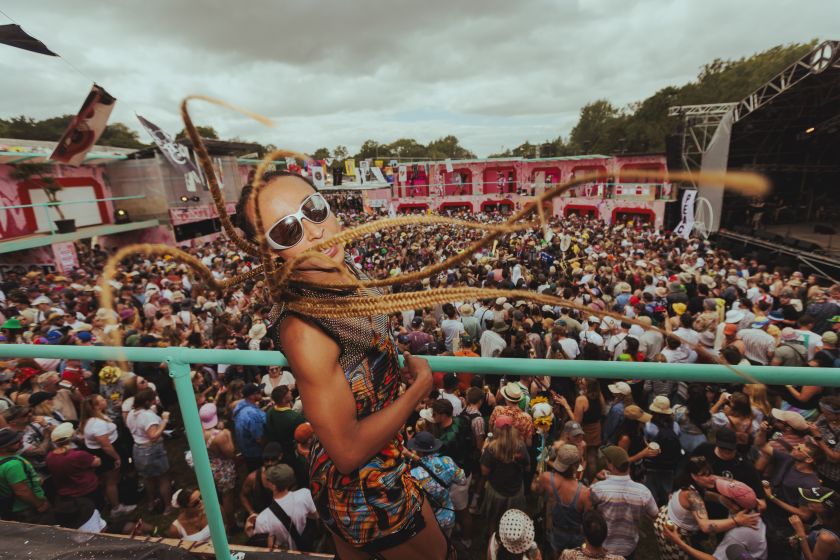Why Glastonbury’s Shangri-La is dramatically reinventing itself for 2025


Photo by Jody Hartley
The radical field in Glastonbury’s Southeast corner will look and feel totally different this year. We chatted with creative director Kaye Dunnings to learn more.
In a dramatic shift from previous years, Shangri-La—Glastonbury Festival’s legendary field of counterculture and alternative music— is completely reinventing itself under the theme of ‘The Wilding’.
After two years parodying consumerism through the ‘Everything Must Go’ concept (which we explored in detail in last year’s special report), creative director Kaye Dunnings and her team are taking that slogan to its logical conclusion… by starting entirely from scratch.
“When we said Everything Must Go, we meant it; everything has gone,” explains Kaye. “This is a chance to start over and make everything new and exciting. And while ‘Everything Must Go’ was about critiquing capitalism and pointing out the problems with it, this new era will be about giving some answers and sharing solutions.”
In short, this will be the most significant transformation in Shangri-La’s 18-year history, with almost nothing returning from previous years in the same form. “We’ve reset our communications, too,” adds Kaye. “This year, we want to celebrate one-on-one, real-life and analogue connections.”
That means, for example, that rather than announcing The Wildings on social media, they sent out hand-crafted packages to press and artists, featuring beautiful limited-edition risograph posters and packets of sunflower seeds—an obvious yet powerful metaphor for the ‘Wilding’ theme.



The 100 limited edition Shangri-La Line-up packages were all handmade in the South West, riso-printed by Josh at 16 Tonne Press, and feature artwork designed by Rosie Lee Wilson. The paper was made by Bristol-based paper company Arboreta Papers and is 160gsm recycled and acid-free.
And that’s not all. From now on, Shangri-La will exclusively be sharing announcements and images via a new mailing list titled Sign up for joy!. The idea is to allow festival goers to stay up-to-date with developments in a calm and curated way, far from the noise and chaos of online life.
A new direction
All this demonstrates how this year’s transformation is far more than just an annual refresh: it’s more of a prototype for a whole new, multi-year vision for Shangri-La.
“We’ve been planning this new direction for the last two years,” Kaye reveals. “It’s almost like a pilot episode, an introductory year because the festival will be taking a year off in 2026 to let the farmland recover. Then, in 2027, we’ll go really deep into the themes we’re covering this year.”
What the new Shangri-La will actually look like is a closely guarded secret, although the organisers will be drip-feeding hints and clues over the next few months. That said, there are a few things that Kaye can share at this stage.
Seeking discovery in a connected world
Firstly, the reimagining of Shangri-La will partly be informed by how visitors have interacted with the space in the past. Kaye notes that many people often bypass, and may not even see, important elements as they rush between the loudest venues.
“So this time around, we’ve redesigned the site so there’ll be multiple options and choices for people to take,” she explains. “The more time you invest in Shangri-La, the more you’ll get out of it.”
A key aim for the redesign, Kaye explains, is recapturing the feeling of genuine discovery that modern technology has largely eliminated. “That feeling of getting lost, I think, is missed,” she reflects. “Shangri-La used to be a bit like that in the very early days, 18 years ago, when we didn’t all have smartphones, Google Maps and What3Words. We were new. We were in the furthest corner from the Pyramid Stage. It was a discovery. And I want to bring a bit of that magic back this year.”




This extends to their approach to promotion, with the aforementioned focus on the newsletter and physical printing. “I’ve been increasingly disillusioned by social media and what it does, how divisive it can be, and how you can’t really avoid adverts anymore,” explains Kaye. “When we first joined social media, you felt part of a community. The same goes for when the internet started: the promise of utopia felt real. Since then, it’s been used for so many things; it’s not what we signed up for any more.”
That doesn’t mean Shangri-La has cancelled its social media accounts altogether. They recognise that many artists still use social media to connect with others, and indeed, so does the festival as a whole. But from 2025, Shangri-La will shift more towards physical connections, typified by the hand-crafted announcement packages we mentioned above.
“Getting something in the mail that’s not a bill or a piece of paper trying to sell you something is a rare, beautiful thing,” stresses Kaye. “Giving a gift is a wonderful thing to do, and I want that to come across with everything that we’re doing in the field as well.”
New stages, fresh experiences
Just in case we haven’t been clear, absolutely everything is being reinvented for this year’s Shangri-La. As another example, they’ll be introducing four completely new music stages: the Shangri-La Main Stage, Lore, Luna, and Azaadi—with only Nomad surviving from previous years. The first of these promises an eclectic mix featuring Gambian-British rapper Pa Salieu, Buenos Aires duo Ca7riel and Paco Amoroso, and Northern Irish rappers Kneecap, whose 2024 set was a festival highlight.
“We really love putting multiple genres in one space,” Kaye explains. “It’s really important that you can see, say, an intense punk band and then something really orchestral on the same bill. Everyone will love something that’s on that stage.”

Photo by George Harrison

Photo by George Harrison

Photo by Jody Hartley
Luna, meanwhile, will host DJ and producer collective Brighter Days Family, London label Ochi, Skepta’s Mas Tiempo, and MAJ!C—a new collaboration featuring Maya Jane Coles, Alex Jones, Jammer, and Chloé Robinson. Lore will showcase experimental cumbia from Frente Cumbiero, futuristic hip-hop with MC Yallah and Debmaster, and a performance from Crass co-founder Steve Ignorant.
Finally, the South Asian programming introduced by last year’s Arrivals stage will continue in 2025 in the form of Azaadi, programmed by Going South and Lila Music. “Arrivals was a vital moment for South Asian music at the festival last year,” says Kaye. “So retaining a South Asian space in Shangri-La was a top priority.” Best of all, she reveals, “The new venue will be physically bigger, so more people are able to enjoy these brilliant, talented artists without having to queue.”
Joy and community
Other musical highlights at Shangri-La will be Fatboy Slim’s 100th Glastonbury show, a celebration of jungle pioneer DJ Randall featuring his son Rio Tashan playing back-to-back with godfather Goldie and uncle GQ, and the return of Joy (Anonymous) with a Joyous People takeover. But while the musical offering remains strong, Kaye emphasises that the Shangri-La experience is about far more than just fresh beats.

Photo by Jody Hartley

Photo by George Harrison

Photo by George Harrison
“The essence of Shangri-La is about the community and the fact that it’s been created by so many different people,” she stresses. So, while in one sense, everything’s changing for 2025, the area should still have that same Shangri-La vibe people have come to know and love.
“In the last couple of years, Shangri-La’s been more like a town; this year, it’ll be more like a village,” she adds. “And while everything will look and feel really different, the humour will still be there, the interactivity will still be there, and the theatricality will still be there. We’re trying to make this new show as authentically Shangri-La as possible. In fact, it might even feel more Shangri-La, in terms of capturing its true essence.”




